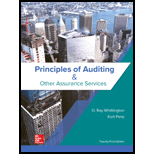
EBK PRINCIPLES OF AUDITING & OTHER ASSU
21st Edition
ISBN: 9781260299434
Author: WHITTINGTON
Publisher: YUZU
expand_more
expand_more
format_list_bulleted
Question
Chapter 11, Problem 36COQ
To determine
Identify the option most likely to be an example of fraudulent financial reporting relating to sales.
Expert Solution & Answer
Want to see the full answer?
Check out a sample textbook solution
Students have asked these similar questions
Calculate fresh Mart's return on assets ROA for the year
Based on this information, determine Laxmi Corporation's total comprehensive income for 2016.
Hi expert please given correct answer with General accounting
Chapter 11 Solutions
EBK PRINCIPLES OF AUDITING & OTHER ASSU
Ch. 11 - Explain the difference between a customers order...Ch. 11 - Prob. 2RQCh. 11 - Prob. 3RQCh. 11 - State briefly the objective of the billing...Ch. 11 - Prob. 5RQCh. 11 - Prob. 6RQCh. 11 - Prob. 7RQCh. 11 - Prob. 8RQCh. 11 - Prob. 9RQCh. 11 - Prob. 10RQ
Ch. 11 - Prob. 11RQCh. 11 - Prob. 12RQCh. 11 - Prob. 13RQCh. 11 - Prob. 14RQCh. 11 - Prob. 15RQCh. 11 - Prob. 16RQCh. 11 - Prob. 17RQCh. 11 - Prob. 18RQCh. 11 - Prob. 19RQCh. 11 - Prob. 20RQCh. 11 - Prob. 21RQCh. 11 - Prob. 22RQCh. 11 - Give an example of a type of receivable...Ch. 11 - Prob. 24RQCh. 11 - Prob. 25QRACh. 11 - Prob. 26QRACh. 11 - Prob. 27QRACh. 11 - Prob. 28QRACh. 11 - Prob. 29QRACh. 11 - Prob. 30QRACh. 11 - Prob. 31QRACh. 11 - Prob. 32QRACh. 11 - Prob. 33QRACh. 11 - Prob. 34QRACh. 11 - Prob. 35QRACh. 11 - Prob. 36AOQCh. 11 - Which of the following would provide the most...Ch. 11 - Prob. 36COQCh. 11 - Prob. 36DOQCh. 11 - Prob. 36EOQCh. 11 - Under SEC rules, which of the following is not...Ch. 11 - Prob. 36GOQCh. 11 - Prob. 36HOQCh. 11 - Prob. 36IOQCh. 11 - Prob. 36JOQCh. 11 - Prob. 36KOQCh. 11 - Prob. 36LOQCh. 11 - Prob. 37OQCh. 11 - Prob. 38OQCh. 11 - An auditors working papers include the following...Ch. 11 - Prob. 40OQCh. 11 - Prob. 41OQCh. 11 - Prob. 42OQCh. 11 - Prob. 43OQCh. 11 - Prob. 44PCh. 11 - Prob. 45PCh. 11 - Prob. 46PCh. 11 - Prob. 47PCh. 11 - The July 31, 20X0, general ledger trial balance of...Ch. 11 - Prob. 49ITCCh. 11 - Prob. 50ECCh. 11 - Prob. 51EC
Knowledge Booster
Similar questions
- Can you solve this financial accounting problem using accurate calculation methods?arrow_forwardLivia's Pastries produces cupcakes, which sell for $6.50 each. During the current month, Livia produced 4,600 cupcakes, but only sold 4,200. The variable cost per cupcake was $3.60, and the sales commission per cupcake was $0.55. Total fixed manufacturing costs were $2,700, and total fixed marketing and administrative costs were $2,000. What is the product cost per cupcake under absorption costing? Answerarrow_forwardSolve with general accounting question and answerarrow_forward
arrow_back_ios
SEE MORE QUESTIONS
arrow_forward_ios
Recommended textbooks for you
 Auditing: A Risk Based-Approach to Conducting a Q...AccountingISBN:9781305080577Author:Karla M Johnstone, Audrey A. Gramling, Larry E. RittenbergPublisher:South-Western College Pub
Auditing: A Risk Based-Approach to Conducting a Q...AccountingISBN:9781305080577Author:Karla M Johnstone, Audrey A. Gramling, Larry E. RittenbergPublisher:South-Western College Pub Auditing: A Risk Based-Approach (MindTap Course L...AccountingISBN:9781337619455Author:Karla M Johnstone, Audrey A. Gramling, Larry E. RittenbergPublisher:Cengage Learning
Auditing: A Risk Based-Approach (MindTap Course L...AccountingISBN:9781337619455Author:Karla M Johnstone, Audrey A. Gramling, Larry E. RittenbergPublisher:Cengage Learning Cornerstones of Financial AccountingAccountingISBN:9781337690881Author:Jay Rich, Jeff JonesPublisher:Cengage Learning
Cornerstones of Financial AccountingAccountingISBN:9781337690881Author:Jay Rich, Jeff JonesPublisher:Cengage Learning- Principles of Accounting Volume 1AccountingISBN:9781947172685Author:OpenStaxPublisher:OpenStax College

Auditing: A Risk Based-Approach to Conducting a Q...
Accounting
ISBN:9781305080577
Author:Karla M Johnstone, Audrey A. Gramling, Larry E. Rittenberg
Publisher:South-Western College Pub

Auditing: A Risk Based-Approach (MindTap Course L...
Accounting
ISBN:9781337619455
Author:Karla M Johnstone, Audrey A. Gramling, Larry E. Rittenberg
Publisher:Cengage Learning

Cornerstones of Financial Accounting
Accounting
ISBN:9781337690881
Author:Jay Rich, Jeff Jones
Publisher:Cengage Learning

Principles of Accounting Volume 1
Accounting
ISBN:9781947172685
Author:OpenStax
Publisher:OpenStax College